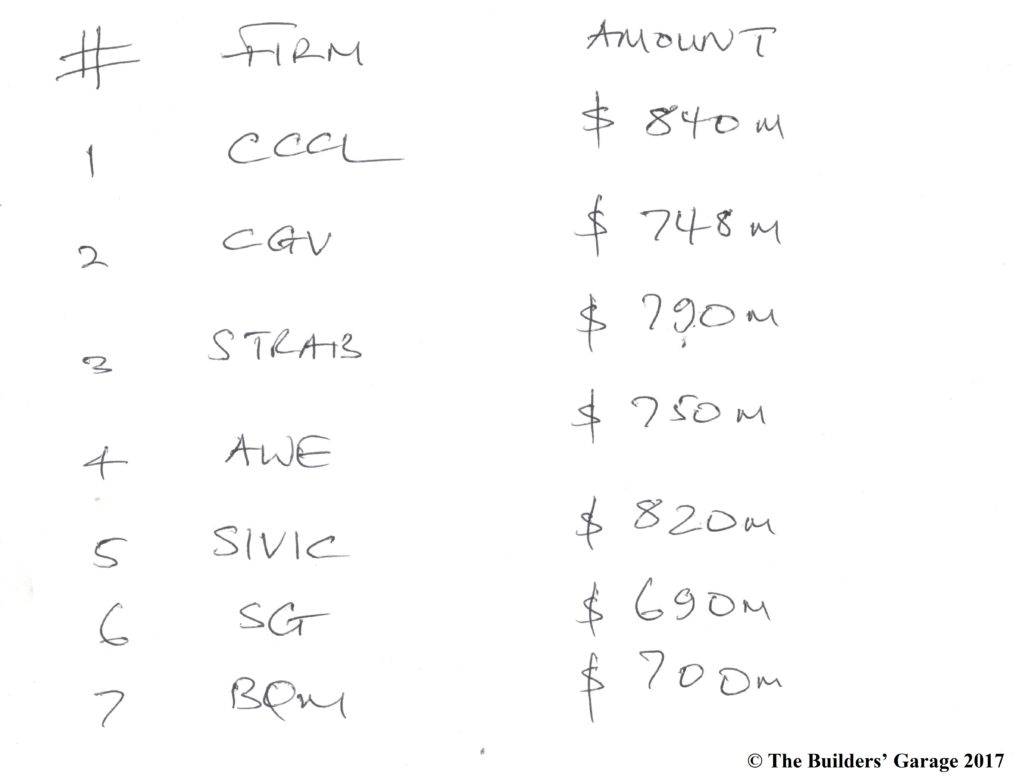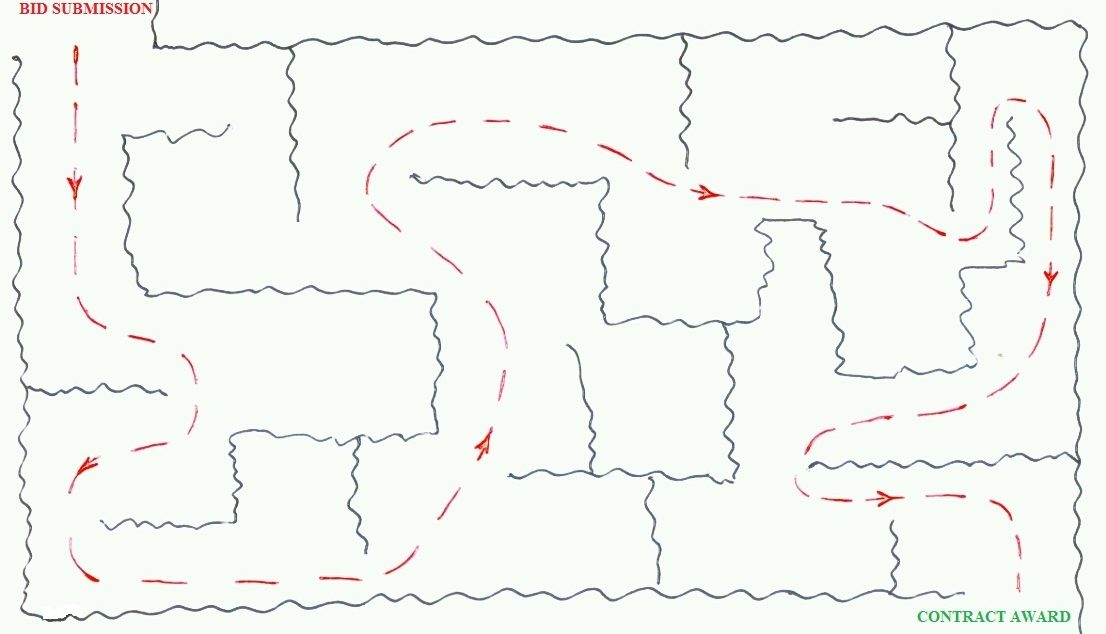The path to contract award – Part One
Malcolm, a Canadian-born engineer I met, prior to the commencement of a bid evaluation process that I was participating in, revealed that the selection of a suitable contractor to carry out construction works for large public infrastructure projects can at times be quite intriguing.
- How I met Malcom
In June 2016, my employer at the time had assembled a team of six individuals to carry out the evaluation of 15 bids for a donor-funded infrastructure project, and Malcolm had been co-opted (as a consultant) to provide specific technical input and by so doing, facilitate the decision making process of the entire evaluation. The exercise was organised and scheduled to last approximately one week at a five-star hotel in the suburbs of a nearby city.
On arrival at the hotel, I noticed an old man in thick glasses, reading the local daily but occasionally looking my way.
“Are you with him?” The woman at the reception asked. “Who, him?” I asked pointing to the four-eyed man. “Yes, with Mr. Malcolm. He is booked into this hotel with your team.”
“It is nice to meet you, Sir”, I responded stretching out my hand, “Cyrus is my name.”
“Cyrus is a wonderful name. You should thank your parents for picking such a great name for you.” He smiled “Thank you,” I replied.
So, Cyrus, how many of such evaluation exercises have you handled? In my case, I have lost count. And I know that this will not be the last.”
“Not too many. This will be the second, and I am not looking forward to it.” I said.
“Why?” Malcom asked with a frown.
“The best evaluated bidder (contractor) might already be known.” I said.
Sensing that I seemed to have a deep understanding of what this exercise could potentially unfold into, Malcom took off his glasses, put the newspaper aside and said, ‘Young man, let me tell you a story.’
- Malcolm’s story
3.1 A client secures financing for the construction of a hydropower dam
In my mid-40’s, I was part of a consultant’s team which had been contracted by an entity in Africa to formulate and implement a project to construct a hydropower dam, a series of sub-stations and approximately 100 kilometers of power distribution lines. Our contract with the entity was a design and supervision contract; the supervision contract becoming effective once the works contract between the successful contractor and the entity was signed.
It took our consultant’s team approximately four months to agree with the entity on the final location for the hydropower dam and the substations, 12 months to produce a detailed design and another three months to produce the required tender documentation.
Midway the preparation of the detailed design, the entity approached about five development banks for a credit facility to finance the construction works. As we proceeded with our detailed design, my team and I were on more than one occasion requested to meet with representatives from the various development banks, each with their own set of financing conditions.
Two months to the end of the detailed design, the entity secured a credit facility to the tune of US$ 800m to cover the costs of physical construction works for the dam, substations and power distribution lines. We were excited to learn that we would be contributing our professional input to the project, but there are pros and cons to every decision in life.
Two months to the end of the detailed design, the entity secured a credit facility to the tune of US$ 800m to cover the costs of physical construction works for the dam, substations and power distribution lines. We were excited to learn that we would be contributing our professional input to the project but there are pros and cons to every decision in life.
At this point, I asked the receptionist whether we could move from the foyer to the lounge as we waited for other members of the evaluation team to arrive. Our wish was granted.
This lounge is fantastic, don’t you think so? asked Malcom. Yes, I said.
3.2 The development partner approves the tender documentation and the tender announcement
We immediately commenced the preparation of the tender documentation after the entity and the development partner had accepted the detailed design. One of the key requirements of the financier (development partner) was that the tender documentation be packaged as a turnkey construction project for specilaised contractors. We obliged and the tender documentation was ready on time.
After a number of iterations to our first submission, the tender documents and the award notice were eventually approved. The tender was announced and a successful pre-bid meeting was conducted three weeks after the date of the tender announcement.
“What was your key role in all of these milestones?” I asked.
“I was the team leader for the design consultancy and later on project manager for the supervision consultancy.” Malcolm responded.
Just as Malcolm was about to continue with our discussion, four colleagues who were part of our evaluation team joined us, and together we proceeded to the evaluation room. When two other colleagues joined us, we all agreed to have a briefing on how to conduct the evaluation.
There and then, Malcolm and I agreed to continue our discussion during the lunch break.
The tender evaluation room was well prepared. The chairs were very comfortable, the room was well lit; Not too noisy and not too quiet. I felt relaxed.
The tender evaluation room was well prepared. The chairs were very comfortable, the room was well lit. Not too noisy and not too quiet. I felt relaxed.
3.3 Submission of the tenders for the construction works.
We did not waste any time at the commencement of our lunch break. Malcolm continued with his story.
About ten companies showed up for the pre-bid meeting and on the day of bid submission (approximately 12 weeks after the tender announcement), seven out of the ten companies submitted bids.
We were requested by our client to witness the bid-opening exercise. “I am sure you have witnessed such an exercise before. If not, you need to. Bid opening is a very nerve-wrecking experience for all the people that are involved. You just do not know what to expect. The prices were read out and they were as follows.”
We were requested by our client to witness the bid opening exercise. “I am sure you have witnessed such an exercise before. If not, you need to. Bid opening is a very nerve racking experience for all the people that are involved. You just do not know what to expect.”
In no particular order, Malcolm scribbled on a piece of paper he had carried in his pocket, the names and offer prices of each of the firms that submitted a bid. I was astounded.

“How do you remember all these prices after such a long time?” I asked. “Cyrus, there are certain things one never forgets,” he smiled.
“And how old are you?” I probed. “Sixty.” he responded.
Competition for the project was cut-throat and in my opinion, it was a clear sign that all the interested bidders understood the nature and complexity of the assignment.
From my earlier experience, I had already pre-determined that the client would have a very competitive evaluation process, because the interested bidders comprised a number of competent companies that were familiar to me. Some, I was hearing of for the first time.
As we were heading back to resume our evaluation exercise, I looked at the list once again to figure out what Malcolm was saying.
After three hours, dinner was served by the poolside overlooking the beautiful night sky, with a live band performing good old country music. It was such an overwhelming experience that we postponed our discussion to the next morning.
Continue to Part Two
© The Builders’ Garage 2017. Permission to use this article or quotations from it is granted subject to appropriate credit being given to thebuildersgarage.com as the source.
Follow The Builders’ Garage on Facebook , like our page to receive updates and leave us a comment
Follow (connect with) the writer (Cyrus Titus Aomu) on LinkedIn


